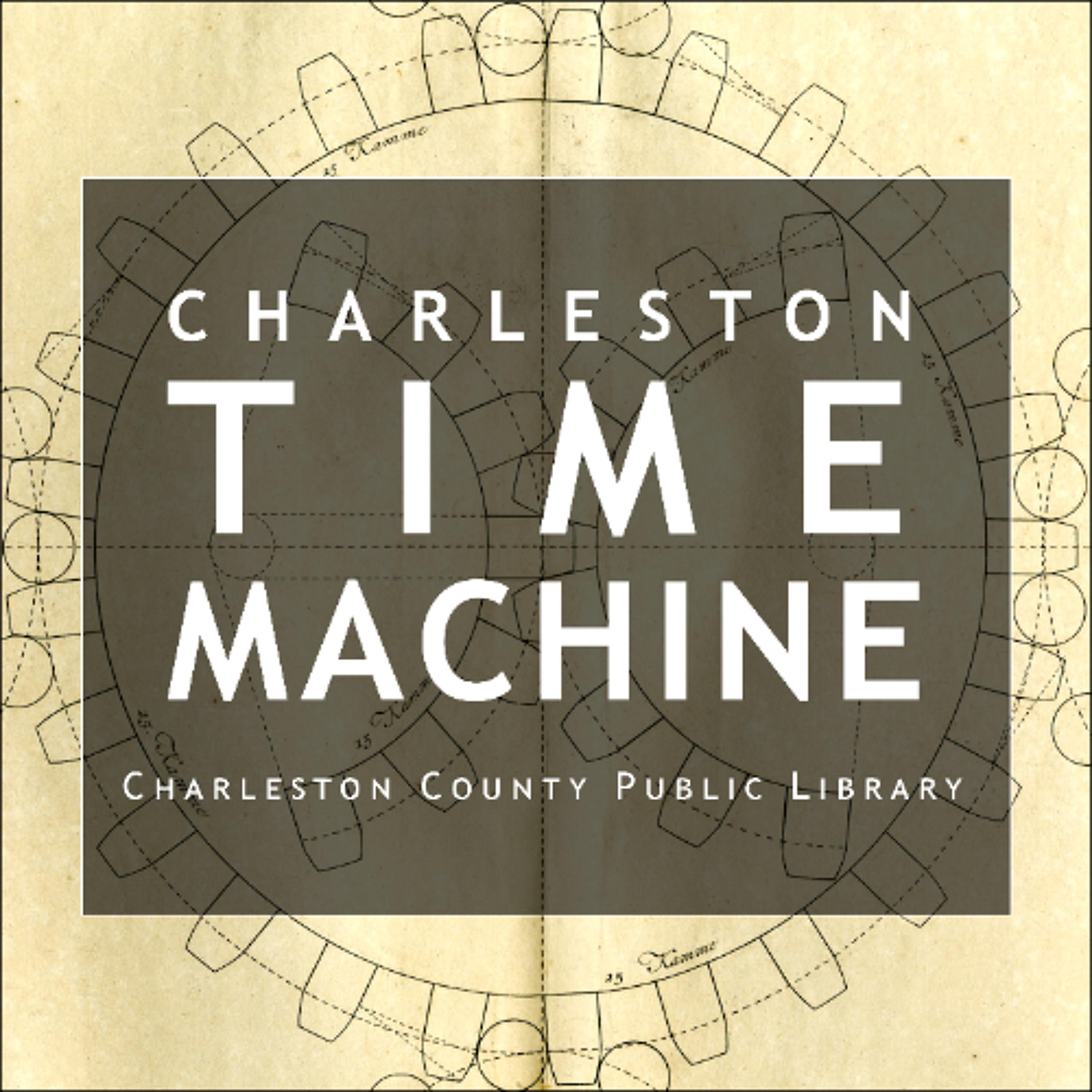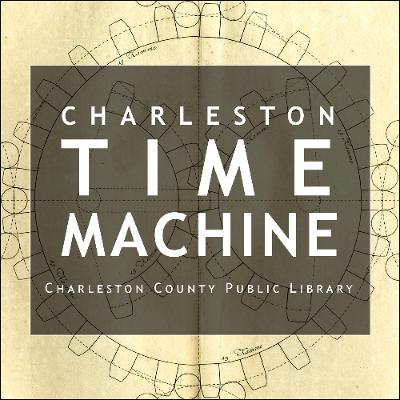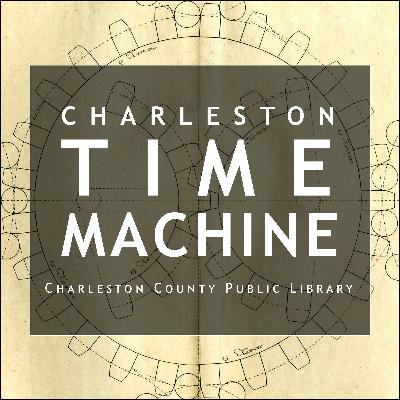Discover Charleston Time Machine
Charleston Time Machine

Charleston Time Machine
Author: Nic Butler, Ph.D.
Subscribed: 146Played: 4,735Subscribe
Share
© All rights reserved
Description
Dr. Nic Butler, historian at the Charleston County Public Library, explores the less familiar corners of local history with stories that invite audiences to reflect on the enduring presence of the past in the Lowcountry of South Carolina.
312 Episodes
Reverse
In the autumn of 1775, rebellious South Carolinians raised a distinctive new flag over a waterfront fort just seized from British hands. Their commanding officer later described the creation of the state’s enduring banner in his memoir, but did not recall the date of its unveiling. Across Charleston Harbor, however, two British naval officers witnessed the flag’s debut and recorded a surprising detail regarding its appearance.
The enclave known as Butcher Town flourished around Cannon’s millpond until 1850, when the expansion of Charleston’s city limits propelled the slaughtering business northward. The migration of butchers’ pens across the Neck then triggered a decades-long battle between private enterprise and public efforts to regulate the industry. Following a suite of political and technological developments in the early twentieth century, a modern municipal abattoir ultimately scrubbed the ancient blood-soaked industry from the local landscape.
The residents of early Charleston lived cheek-by-jowl with the animals they consumed, and routinely witnessed cattle, pigs, sheep, and goats trotting through urban streets to meet the butcher’s blade. Efforts to push this bloody business out of the city center commenced in the late 1690s and evolved over the following century, during which local officials gradually pushed the slaughtering trade northward to a tidewater suburb that became known as Butcher Town.
In the spring of 1807, nineteen years after the initial creation of Market Street, Charleston’s municipal government faced a looming deadline to complete the proposed but long-delayed public marketplace. To avoid a second forfeiture of the extensive property donated by generous neighbors, City Council launched a rapid series of construction projects and drafted a landmark ordinance, the text of which defined the culture of urban food sales for the ensuing century.
Amidst another influx of French-speaking refugees in the spring of 1804, Charleston’s municipal authorities negotiated with property owners to resuscitate the Market Street plan scuttled more than a decade earlier. Charles Cotesworth Pinckney, the project’s principal donor, dictated new terms to city officials and set a three-year deadline, triggering a flurry of site work and legal negotiations that eventually secured the permanent establishment of the present historic marketplace.
Following the conversion of the city’s new Beef Market into a dormitory in the autumn of 1793, the business of vending fresh provisions in Charleston meandered across the urban landscape for more than a decade. The older marketplaces in Tradd and Queen Streets absorbed most of the central-city commerce, while residents of peripheral neighborhoods briefly patronized forgotten smaller markets on South Bay and the east end of Calhoun Street.
The legal foundation of Market Street, created in 1788, dissolved in 1793 when the City of Charleston scrambled to address a refugee crisis that shocked the community. Few in the Palmetto City today recall how a revolutionary struggle for civil rights in the Caribbean island of Hispaniola sparked a bloody insurrection that forced thousands of French-speaking migrants to seek asylum here and in other port cities of the United States.
Market Street and its venerable public buildings exemplify the spirit of preservation and resilience in modern Charleston, but forgotten details of the site’s creation in the late eighteenth century shroud a troubled genesis. The city’s broadest thoroughfare was mostly underwater during its early years, and the site’s first edifice sheltered butchers only briefly before a distant political crisis unraveled its legal foundation.
In the spring of 1751, Governor James Glen described the Cooper River as “a kind of floating market,” hosting “numbers of canoes boats and pettyaguas that ply incessantly, bringing down the country produce to town.” In today’s Time Machine, let’s follow those watercraft to a series of market sites along the Charleston waterfront and explore the daily routine of vending fresh victuals during the community’s first century.
Modern travelers across the city and county of Charleston roll across a continuous ribbon of asphalt that facilitates an expanding cycle of population growth and cultural diversity. The roots of this blacktop conveyor belt extend back more than century, when a series of obscure political changes unleashed an unprecedented burst of infrastructure development that literally paved the road to Charleston’s present economic prosperity.
During the twilight years of the nineteenth century, radical changes to local thoroughfares helped the City of Charleston evolve from a declining seaport into a tidy modern metropolis. Uniform blocks of durable granite displaced most of the city’s lumpy cobblestone streets during the 1880s, after which the municipal government achieved mixed results with trials of several curious paving compounds.
Amidst the financial doldrums that followed the American Civil War, Charlestonians struggled to reconstruct their politics, rebuild their economy, and repair a neglected streetscape. Budget constraints compelled officials of the late 1860s and 1870s to perpetuate old-fashioned paving habits and to recycle outdated materials, but a few novel additions to the public right-of-way cheered the spirits of local drivers, pedestrians, and velocipedestrians.
Charleston’s cobblestone streets fascinate residents and visitors alike, inspiring visions of pirates and horse-drawn carriages rattling through ye olde colonial capital. Imported from Europe as ship ballast since the 1670s, these roundish stones provided the city’s earliest street covering, but the campaign to pave local thoroughfares with cobbles didn’t commence until the early 1800s. To better understand the traveling conditions endured by early Charlestonians, let’s take a stroll through paving history from colonial times to the American Civil War.
Frederick Douglass (1818–1895) was a towering figure in the history of the United States, occupying the vanguard of the nation’s struggle for African-American civil rights during the nineteenth century. Near the end of his celebrated career, Douglass visited Charleston in the spring of 1888 as part of a lecture tour across several Southern states. His brief tenure in the Palmetto City inspired members of the local Black community, while their frank conversations challenged Douglass’ view of the state of American racial politics.
Orange trees and their delicious fruit are not native to North America, but they form a curious and poorly-remembered chapter in South Carolina’s early history. During the second quarter of the eighteenth century, British settlers planted thousands of orange trees in the Charleston area to capitalize on the fruit’s high commercial value. Although cold temperatures ended dreams of an orange bonanza before the American Revolution, vestiges of Charleston’s colonial citrus experiment survive on the modern landscape.
Can you imagine navigating the streets and roads of Charleston County between dusk and dawn without the aid of street lamps? The earliest inhabitants of this area relied on moonlight to guide their steps at night, but a campaign to provide nocturnal illumination commenced in the third quarter of the eighteenth century. The number of street lamps fueled by whale oil, then manufactured gas, then electricity gradually increased over the decades, establishing the comforting but unnatural glow that brightens the night sky over modern Charleston.
Thanksgiving, an American holiday rooted in harvest celebrations, acknowledges the bounty of food so many of us take for granted. This tradition in South Carolina recalls the meals shared by English adventurers who landed at Albemarle Point in 1670. They arrived with modest supplies of perishable provisions and planned to sow fresh crops immediately, but a series of misfortunes quickly eroded their food security. The survival of the infant colony depended on contributions from hospitable Native Americans who sustained the hungry immigrants during a season of need.
The place-name “Charleston Common” applies to a large swath of land reserved for public use since 1735. Conscious that the provincial capital lacked a traditional English common, South Carolina’s colonial government designated approximately eighty-five acres abutting the Ashley River for the perpetual use of all inhabitants. Municipal leaders violated that trust through a series of questionable sales, however, leaving just fifteen acres of the forgotten common at three sites now identified as Colonial Lake, Moultrie Playground, and Horse Lot Park.
The trial of Hispanic carpenter Joseph Lortia, accused of confederating with pirates aboard the Cuban schooner Nuestra Señora, unfolded through a series of episodes within South Carolina’s executive Council Chamber in July 1734. Conflicting testimony from the survivors recounted Lortia’s odd behavior at sea and challenged Anglo-American judges to determine the measure of his guilt. After settling the carpenter’s fate in court, Governor Robert Johnson restored the vessel’s remaining treasure to the widowed Doña Petrona de Castro, who sailed from Charleston with her newborn child.
The young Cuban widow, Doña Petrona de Castro, suffered in the shadows during the first half of this story, but moved to center stage after the bloodied vessel Nuestra Señora docked in Charleston. When her disheveled treasure came ashore in late June 1734, the pregnant lady’s plight attracted the personal attention of South Carolina’s respected royal governor. Under his personal supervision, members of the provincial government secured the señora’s private property and initiated steps designed to render solace to their distressed Hispanic guest.







